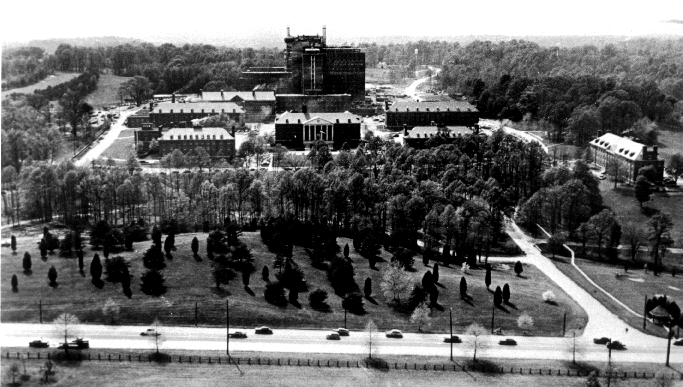FROM THE DEPUTY DIRECTOR FOR INTRAMURAL RESEARCH
NATIONAL INSTITUTES OF HEALTH:
THE SHAPE OF THINGS TO COME, PART I
 Michael Gottesman
Michael Gottesman
Futurism is back in style. At the risk of being overtaken by events
beyond our control, it's often tempting to follow the lead of H.G. Wells and
conjure up a picture of what the future may hold. At times of change -- such as
the present -- it is reassuring to hear that our most cherished institution,
that is, NIH, will be thriving in years to come. This two-part commentary is
intended to give NIH scientists and support staff a glimpse into the likely
future of our institution. Part I will address how the evolution of NIH's
physical environment will shape our scientific lifestyle. Part II will detail
science-management issues that affect the way we conduct research. The opinions expressed in this commentary are strictly my own and are based on what I see as the most likely course of events for NIH over the next couple of decades. Here are the assumptions:
- NIH's overall budget will remain stable, barely keeping pace with inflation.
The intramural share of this budget will be subject to even greater pressure to
decrease it, reflecting the current move to "downsize" all government
activities and the requirement that we reduce intramural full-time employees by an additional 5% over the next four years. Current projections of a 3% growth
in the intramural budget translate into a 1% to 2% drop in buying power each
year based on the current rate of biomedical inflation.
- The current population of the Bethesda campus -- approximately 16,350 people
-- will grow very little, if at all, over the next 20 years. The highest
estimates of NIH's population, which are based on potentially moving some
outlying scientific programs back to the main campus, project no more than 10%
growth over the next two decades. To me, a no-growth scenario seems most
likely, with a continuing decline in the existing NIH campus population being
barely offset by the transfer of outlying programs back to the main campus.
- NIH will be responsive to lifestyle concerns raised by our staff and
neighbors so that we can work in safe laboratories on an aesthetically pleasing
campus. We will continue to reduce the creation of hazardous waste, to improve
disposal of hazardous waste, and to recycle nonhazardous solid waste. We also
want to serve as a model and a resource for the community in matters of science
and cultural activities, health-related concerns, and noise and traffic
abatement.
The 1972 NIH Campus Master Plan -- the major document guiding physical
changes on the main campus -- is now obsolete. A new Master Plan spanning the
next 20 years is currently being drafted by the Office of Research Services.
That plan, which must be submitted to Congress and the National Capital Park
and Planning Commission by June 30, allows NIH to change its buildings and its
infrastructure, such as electrical lines and roads, without getting explicit
approval for each change, but still requires individual environmental studies.
As might be expected, there is enormous interest in the new plan. The Office of
Research Services is planning a number of opportunities for broad NIH input,
and every scientific director on campus has already been interviewed.
Meanwhile, Janyce Hedetniemi, director of the Office of Community Liaison, has
established a working group of 35 community leaders to provide community input
into the final product.
The new Master Plan will likely contain many of the following features: 1)
modification of roads, walks, and bike paths to make the campus easily
accessible to all, 2) demolition of Buildings 7 and 9 -- obsolete structures
unsuitable for 21st century science, 3) conversion of historically significant
Buildings 2 and 3 into office space, 4) construction of two new buildings -- a
consolidated laboratory to replace Buildings 2, 3, and 7 and a new hospital
with associated labs that will likely be attached to the north side of the
existing Clinical Center, and 5) renovation of older research buildings,
especially labs in the Clinical Center.
The overall effect of these changes will be to improve the utility, safety and
appearance of NIH. Given the declining number of scientists on campus and a
small net increase in total lab space, the average space per researcher should
increase. From my perspective, this is an extremely positive development.
Currently, our labs are entirely too crowded and our hallways are groaning with
equipment and supplies. Relief is needed. In the short term, we must exercise
restraint in the number of people we cram into available space. In the long
term, the combination of a bit more space and enforced downsizing should
improve our lab conditions.
Improvement is also on the horizon when it comes to the environmental
challenges that face NIH and our neighbors. The Environmental Concerns Working
Group, which has NIH and community membership, has set up several subcommittees
to address concerns about medical pathological waste (MPW), bulk mail, and
community health. The subcommittees have already made the following
recommendations:
- Continue to reduce the generation of MPW. Although MPW has been cut 19% in
the past few months, an additional 20% to 30% reduction should be attainable
through more judicious use of MPW boxes. Analyze options for "closed"
sterilization systems to replace the need to truck MPW to Baltimore for
incineration.
- Extend white-paper and aluminum-can recycling to more parts of campus. Begin
interim plans to recycle polypropylene pipet-tip holders and other plastics.
Prepare for a long-range plan to recycle 50% of the solid waste on campus -- an
effort that has been initiated, but will take about two years to fully
implement.
- Solicit short-term solutions for reducing unwanted bulk mailings. Lay the
groundwork for replacing paper catalogs with electronic ordering systems over
the next few years.
- Analyze epidemiological data for Bethesda to determine whether any
environmentally related disorders occur more frequently near NIH than
elsewhere.
As an NIH scientist, before taking the helm of the Office of Intramural
Research, I often felt that things just happened on campus without any input
from scientists. Therefore, I want to seek your advice and keep you informed
about the shape of things to come. Send your comments on this article to me via
computer (e-mail: gottesmm@od1em1.od.nih.gov) or FAX-BACK to The NIH
Catalyst (fax: 402-4303).
Michael Gottesman
Deputy Director for Intramural Research

Time marches on. NIH's Bethesda campus circa 1951. Note that the Clinical Center is just under construction.
Table of Contents
 Michael Gottesman
Michael Gottesman
